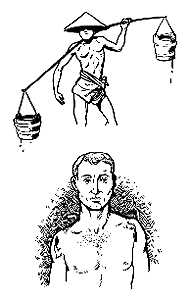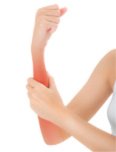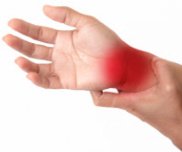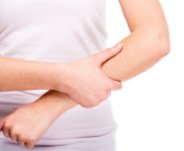The Collarbones
The collarbones (clavicles) sit on top of the ribcage and form a sort of "yoke" spanning from shoulder to shoulder. The two clavicles are joined at the middle at the sternum (breastbone) by a cartilage joint. Just like all other structures in the body, these bones are suspended in place by opposing muscle groups and the fascia of the upper body.
The Structural Balance Of The Collarbones
There are several muscles which attach to the collarbones and are therefore responsible for holding them in place. They are the sternocleidomastoid (SCM), the trapezius, the pectoralis major and the subclavius muscles. Imbalance in any of these muscles can disturb the normal position of the clavicles. Because of this, it is important to rebalance all of these muscles, even though they may not directly impact the brachial plexus or the veins and arteries that serve the arm.

Just like a yoke on a pair of oxen, when one collarbone is pulled down, the other one often tips upward leading to a posture that looks a little tilted. How you use your body can also contribute to this imbalance. An example would be someone who habitually carries a heavy object, like a briefcase, a heavy tray of food, or a child on one side of the body.
The Collarbones and Thoracic Outlet Syndrome
The position of the collarbone, especially as it relates to the first rib which lies underneath and behind it, can contribute to the symptoms of TOS that you might be dealing with.
This entire area is packed with muscles, fascia, blood vessels, nerves and other bones. It's an anatomical traffic jam! So, when a big structure like the collarbone goes out of alignment, all the other surrounding structures and tissues shift in compensation. When that shifting ends up squeezing a nerve or blood vessel, the symptoms of TOS can develop.
The key to neutralizing the effects the clavicles have on TOS is to restore structural balance to the whole area. And it's not simply about getting these bones back into their normal position, but rather restoring balance to all the muscles, fascia and other bones that can have an impact on the nerve bundle passing through this area.
Because the collarbones lie in front of and slightly above the first rib, that relationship is critically important. The main nerve bundle, the brachial plexus and the main arteries and veins that serve the arm pass right through the space between the collarbone and the first rib.
If the first rib is raised for any reason, it will squeeze the nerves and blood vessels against the collarbone. If the collarbone is pulled down for any reason, it can also squeeze the brachial plexus against the first rib.
Over time, the suspending fascia in the area (known as the costoclavicular fascia) can become less fluid and more restrictive, further complicating the problem. And because the costoclavicular fascia extends down into the ribcage, restrictions there can contribute to a pattern of slouching which will further disturb the normal structural balance.
So, the story of the collarbone and how it affects TOS is a story of relationships and balance. The better the balance between all the structures around the collarbones, the less impact any of these will have on Thoracic Outlet Syndrome.
For further information, also visit:
Click the block below that most closely matches your injury for more information and to find the Toolkit we offer to help you in your recovery.







